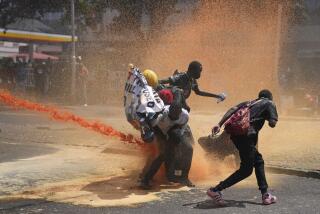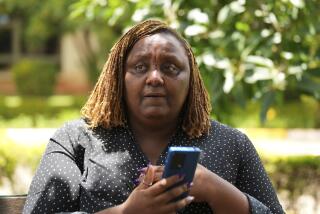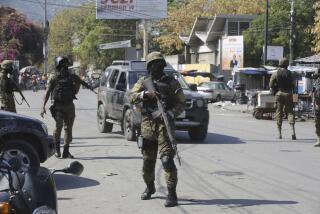Deaths in Embassy Blasts Rise to 147; Rescuers Probe Rubble
- Share via
NAIROBI, Kenya — International rescue teams continued a painstaking search for survivors beneath hunks of collapsed concrete Saturday as the death toll from terrorist bombs outside the U.S. embassies in Kenya and Tanzania rose to at least 147, with more than 4,800 injured.
Thirty-six hours into the search, an Israeli-led crew salvaged Kenya’s floundering rescue effort and boosted the nation’s spirits when they extracted a 45-year-old businessman from beneath the debris. Francis Nganga, who had talked for hours to medical workers through a thick wall of concrete, suffered a broken leg but was conscious and expected to survive.
“Get me out of this place,” Nganga told rescue workers struggling to free him.
While U.S. officials say the bombs were aimed at American targets, Africans suffered the vast majority of casualties.
Eleven Americans and 14 Kenyan employees of the embassy were among the dead in Nairobi. One U.S. diplomat was still missing in the ruins, and 109 African employees of the mission were unaccounted for, although U.S. officials said they hoped that many had returned to homes without telephones.
In the Tanzanian capital of Dar es Salaam, at least eight people died and more than 70 were reported injured in the bomb blast there, which destroyed most of the U.S. Embassy and some nearby buildings. The search for survivors ended Saturday in that sleepy East African city, where no Americans were among the dead.
The United States, France and Israel sent rescue teams to help the Kenyan army try to free survivors from the collapsed Ufundi Cooperative House next to the embassy. The Israelis, with their ample experience in cleaning up after terrorist attacks, led the operation using 20 tons of high-tech search equipment and a squad of eight trained dogs.
The search dogs found seven bodies buried beneath office equipment and other debris in the American Embassy and at least five bodies in the Ufundi office building, an Israeli army spokesman said. He said there are no more survivors in the embassy building.
Israeli army commanders arrived late in the afternoon and quickly transformed the well-intentioned but inexperienced Kenyan effort into a precision military operation.
They immediately overruled the Kenyan decision to approach survivors by burrowing into the base of the disaster scene, opting instead to remove massive slabs of concrete by crane from above.
“It is dangerous to go from downstairs to upstairs, so we go upstairs to downstairs,” said Col. Isaac Ashkenazi, the surgeon general for the Israeli rescue team.
Attention Turns to Last Known Survivor
After pulling Nganga from a ground-floor hallway just before 10:30 p.m., the Israeli squad of 170 soldiers turned their attention to the last known survivor of the blast, a woman identified as Jane.
Medical workers had been speaking to the woman through Nganga, who was able to hear her by means of a network of connecting cubbyholes, cracks and caverns in the rubble.
“She is further inside, but she told him, ‘It is OK,’ ” Ashkenazi said. “We will work through the night.”
The first of more than 60 FBI officials also arrived Saturday to open what is expected to be a lengthy investigation into the bombings that shocked both African countries, which have friendly relations with the United States. The rest of the team is due today.
U.S. officials refused to speculate on who might have carried out the worst attack on an American compound since 19 U.S. airmen were killed and 500 were wounded at the Khobar Towers barracks in Saudi Arabia in June 1996. That case has not been resolved.
The Kenyan Daily Nation, quoting witnesses, reported Saturday that a man was spotted driving a pickup truck into the parking lane between the embassy and the Ufundi building at 10:28 a.m. The witnesses said he remained in the truck until the bomb exploded several minutes later. The newspaper said the information had been corroborated by U.S. security officials and Kenyan police, although American officials would not confirm the report.
Statements by a previously unknown Islamic group sent Saturday to a television station that broadcasts to the Persian Gulf region said the Nairobi bombing was carried out by two men from Mecca, Saudi Arabia, while an Egyptian staged the Dar es Salaam attack. It did not mention the men’s fate.
Similar statements were sent to Radio France International and a London-based Arabic newspaper. There was no indication that the senders could provide evidence for their claims, and it was not immediately known whether U.S. investigators would give credence to the claim.
In his Saturday radio address, President Clinton vowed to redouble the United States’ ongoing fight against terrorism and not allow the bombings in Africa to shake American resolve.
“The most powerful weapon in our counter-terrorism arsenal is our determination to never give up,” Clinton said. “No matter how long it takes or where it takes us, we will pursue terrorists until the cases are solved and justice is done.”
In Nairobi, U.S. Ambassador Prudence Bushnell, with a stitched lower lip and bandaged hands, made her first public statement since she was injured in the Friday morning explosion.
“Literally thousands of people came face to face with evil, and the result is broken hearts, shattered lives, shock, dismay, anger and, most of all, incredible sorrow,” Bushnell said in a voice breaking with emotion.
Survivors of the attack reported hearing an explosion like a heavy thud about 10:40 a.m. Friday, followed by gunfire. About 10 seconds later, a car bomb exploded, bringing down half the embassy and the Ufundi building in a maelstrom of fire, dust and rubble.
At almost the same time as the Nairobi blast, another bomb exploded in the Tanzanian capital, Dar es Salaam, about 450 miles away.
Bushnell said that a review of embassy security was carried out two months ago and that new protective grills had been ordered to cover the front of the building in downtown Nairobi, but she noted that those would have been useless against the explosion in the rear of the building.
She said the perimeter was monitored by surveillance cameras and protected by unarmed security guards patrolling on foot. A metal barrier blocked the entrance to the embassy parking lot, and the trunks and undersides of entering cars were checked before they were allowed on the grounds.
Embassy Was Highly Vulnerable
Nonetheless, the embassy was highly vulnerable because it is on one of the busiest intersections in Nairobi’s commercial and government center.
Officials have not said how big the bomb was, but it was strong enough to rip out a row of heavy metal security posts embedded in concrete slabs.
The explosion left several square blocks of downtown Nairobi a shambles, its streets covered in glass from broken windows. The area is closed off now by the Kenyan army. The embassy is closed, its back half a mangle of metal and concrete.
The Pentagon identified the military casualties as Air Force Senior Master Sgt. Sherry Lynn Olds, 40, of Panama City, Fla., assigned to the Air Force security element in Nairobi; Marine Sgt. Jesse N. Aliganga, 21, of Tallahassee, Fla., part of the embassy’s security unit; and Army Sgt. Kenneth R. Hobson II, 27, of Nevada, Mo., assigned to the office of the Defense attache in the embassy.
Secretary of State Madeleine Albright released the identities of seven others: Jay Bartley, son of Consul General Julian Bartley; Jean Dalizu, Defense attache’s office; Molly Hardy, administrative office; Prabhi Kavaler, general services office; Arlene Kirk, military assistance office; Michelle O’Connor, general services office; and Tom Shah, political section. Relatives had said Hardy was 51 years old, Kirk, 50.
In addition, relatives identified the 11th victim late Saturday as Louise Martin, 45, of Atlanta, an employee of the U.S. Centers for Disease Control and Prevention.
Albright said one American diplomat remained unaccounted for.
In San Diego, KNSD-TV quoted Anita Gomes, a spokeswoman for the United States International University, as saying that the younger Bartley was enrolled at the university’s Nairobi campus.
“His father, [Julian] Bartley, is the U.S. consul general at the embassy there and he is still missing,” she said.
The State Department declined to confirm or deny that Bartley was the missing diplomat mentioned by Albright. It has set up a number for families to call to check on relatives who may be affected by the bombings in Kenya and Tanzania. It is (202) 647-0900.
(BEGIN TEXT OF INFOBOX / INFOGRAPHIC)
Probing Blasts
In any bombing case, whether on U.S. or foreign soil, investigators attempt to reconstruct the bomb and the site as they existed an instant before the explosion. It is a painstaking process of physical reconstruction, examination of the damage done by the explosion and chemical analysis. Data from this detective work are matched with relevant information in databases worldwide.
RECONSTRUCTION
* Debris from the site, which can cover an area of many square miles, may be gathered for reassembly. In some cases, literally tons of material are collected and sifted through sieves to pick up even the tiniest pieces.
* As rubble and debris are accumulated, even by vacuuming in some cases, items such as door handles, vehicle parts and pieces of the building may be collected.
* Investigators search for pieces that belong to the bomb itself, including parts of circuitry, clocks, radio devices or pieces of the vehicle that carried the explosives.
* The identification of even very small parts can lead investigators to a bomb-building manual, a manufacturer, country of origin and ultimately to the perpetrators. Some groups and individuals leave “signatures” on their work. Such information is shared by investigators worldwide.
CHEMICAL ANALYSIS
* As much as 90% of the bomb’s chemical residue is left at the scene, but the explosive substance changes form chemically in the blast.
* Every surface subjected to the initial blast ends up coated with a chemical residue.
* By analyzing this residue, investigators determine the makeup of the original material.
Source: Brian Jenkins, Kroll Associates; Associated Press; researched by NONA YATES / Los Angeles Times
More to Read
Sign up for Essential California
The most important California stories and recommendations in your inbox every morning.
You may occasionally receive promotional content from the Los Angeles Times.










